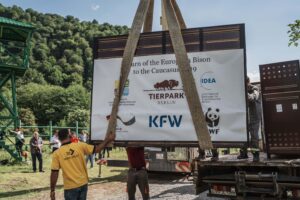
Transportation
Selection, Transport and re-introduction process of European Bison
To provide suitable animals for the reintroduction process, the EAZA/EEPEuropean Bison breeding program Coordinator, together with the breeders, selects every year up to 10 European Bison for the reintroduction centre in Shahdag NP. Selected animals are donated by the breeders for the project and are transported for most of the animals, first to Tierpark Berlin and later to the reintroduction site. In Tierpark Berlin the animals are habituated to form a group and later prepared for the further transport to Azerbaijan. To reduce the transportation time to a minimum, animals are transported from Tierpark Berlin to Frankfurt/ Hahn Airport by truck in special constructed crates. From here animals are transported by plane from here to Baku/Azerbaijan and then by truck to the reintroduction centre. During the entire transport the animals are attended by a veterinarian and wildlife biologist.
The reintroduction process takes part in several phases. After the transport from Europe, the animals are released from their transport boxes into an acclimatization or adaptation enclosure to allow close supervision, management and, if needed, treatment. The acclimatization enclosure has a handling area with two holding pens to manage European Bison and separate animals if necessary. This first stage also functions as a quarantine period. Thereafter animals are allowed into the adjoining rewilding area, a valley of about 280 ha that is contained by electric fences on the ridges. In the rewilding area, the animals are prepared to fully adapt to their new habitat but still within a restricted area. Supplementary feeding is provided to a minimum and only in case of need (e.g. winter).
Both health condition and behaviour of the bison are closely monitored by animal caretakers and staff from the NP. A team of experienced European Bison veterinarians consult with the project in case any treatment is needed. When the condition of the animals is good, and they have formed a good, natural behaving herd, they are released to the core zone of the NP. The project aims to bring to Shahdag National Park around 10 individuals per year with a goal to reach a population size of 100 animals by 2028. All animals will follow the same two-stage acclimatization and rewilding procedure. Along with calves born within the herd, this gradually will help to build a viable population in the long term.
As the population grows, it will create economic opportunities for wildlife tourism.
